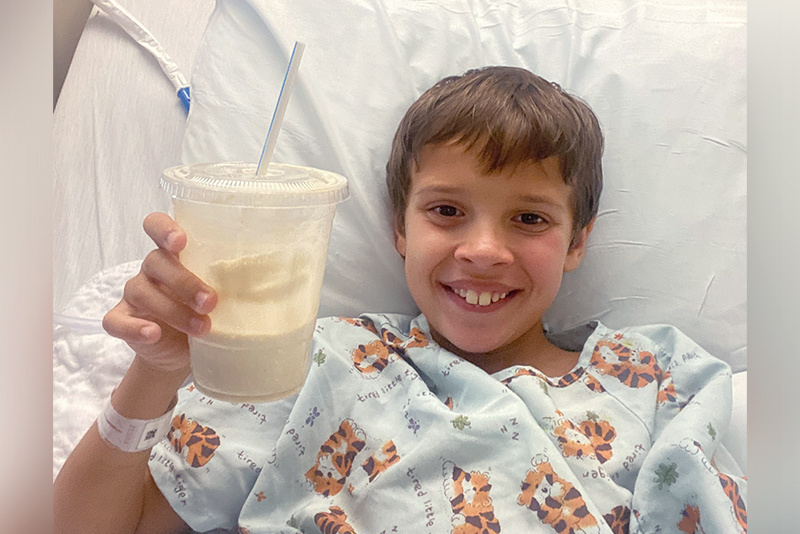From PediaSure to pizza: Benjamin’s journey with esophageal stricture

This fall, Benjamin Hawkins and his family visited a local orchard to go apple picking. It’s a beloved tradition for many people, but this visit was extra special for Benjamin: For the first time in his life, he could take a big bite out of the apple he’d just plucked from a tree. In fact, for most of his nine years, he had been unable to swallow solid food.
Benjamin had difficulty feeding almost as soon as he was born, says his mother, Amanda. “I was a first-time mom and thought it was just normal baby reflux,” she remembers. When different feeding positions and techniques didn’t work, his pediatrician prescribed medication. But when he couldn’t transition to stage 3 baby foods like mashed vegetables, Amanda and her husband, Ben, knew it was time to see a specialist.

A severe stricture
By the time Benjamin was 18 months old, a gastroenterologist in his home state of South Carolina had diagnosed him with an esophageal stricture, a narrowing of the tube that connects the mouth to the stomach. Strictures can make it difficult for children to swallow, a problem called dysphagia. Benjamin’s stricture was so severe that even multiple procedures known as dilation couldn’t keep it open.
As a result, Benjamin’s blood sugar dropped and he lost weight, leading to countless emergency department visits and hospital admissions. He often vomited and aspirated food and liquids. When he was 6, he began to rely on a feeding tube to help him get his nutrition for the times his esophagus became too narrow for liquids. Dissatisfied with the status quo, Amanda and Ben did some research and discovered the Esophageal and Airway Treatment (EAT) Center at Boston Children’s Hospital. When they learned that Benjamin’s gastroenterologist had actually been a fellow there, he happily referred them.

Jejunal interposition was ‘worth it’
After some delays due to the pandemic, the family made it to Boston Children’s, where they learned that Benjamin’s stricture had worsened. Dr. Benjamin Zendejas-Mummert, surgical director of the EAT Center, recommended removing the stricture and lower part of his esophagus, followed by a jejunal interposition. In this procedure, surgeons replace the missing section of a child’s esophagus with a section of the jejunum (the middle part of the small intestine).
Benjamin underwent the surgery in July 2022. “We knew that the recovery would be tough, but we hung on to the likelihood of a positive outcome,” says Amanda. Benjamin agrees. “It was scary, but it’s been worth it,” he says. He also liked that his younger siblings could visit him at Boston Children’s and play with LEGOs and other toys, thanks to the hospital’s Child Life Services.

Reveling in the right choice
Almost six months later, it’s clear to Benjamin and his parents that surgery was the right choice for him. Where he once could only consume PediaSure and yogurt by mouth, he’s now able to eat whatever he likes. He’s gained weight and revels in being “just like his friends,” says Amanda, playing Minecraft, hanging out with his dog, Rocket, and, best of all, enjoying his new favorite food — pizza. And he won’t have to see his Boston Children’s gastroenterologist, Dr. Jessica Yasuda, for another year. Aside from Benjamin’s improved health, one of the greatest benefits of the experience has been finding answers, says Amanda. Once desperate for information, she created a Facebook group about esophageal strictures in kids. Now, “We get messages all the time from other families in this situation,” she explains. “I want to share what we’ve learned and be a resource for them. It’s a hard path to walk alone, and I’m very grateful we made it.”
Learn more about the Esophageal and Airway Treatment Center.
Related Posts :
-

Ready for the next step: Innovative care for Chase
Chase Essex loves pizza and has even prepared shrimp scampi for his family. So it might come as a surprise ...
-

Making up for lost time: Living with esophageal atresia
Whether he’s riding his dirt bike, learning how to swim, playing with his dogs and cats, or herding the ...
-

‘The best decision we ever made’: Bridging the gap for Arya’s esophageal atresia
When Teja and Naveen learned last year that their daughter, Arya, would be born with long-gap esophageal atresia (EA), they ...
-

Beyond limits: A staged approach to jejunal interposition
By the time Chase Essex arrived at Boston Children’s Hospital in 2016, he had reached what most clinicians would consider ...





